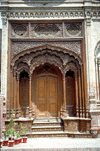Umar Hayat Mahal
A number of historical buildings in Chiniot tell the tales of its glorious past. One of them, Umar Hayat Palace (also called Gulzar Manzil), is a masterpiece of indigenous art and architecture, located in the centre of the city. If architecture is frozen music, then Guizar Manzil in Chiniot is the creativity of human spirit, with its beautiful Jharokas (balconies) and exquisitely engraved arches. It has a great attraction for local and foreign tourists.
A number of historical buildings in Chiniot tell the tales of its glorious past. One of them, Umar Hayat Palace (also called Gulzar Manzil), is a masterpiece of indigenous art and architecture, located in the centre of the city. If architecture is frozen music, then Guizar Manzil in Chiniot is the creativity of human spirit, with its beautiful Jharokas (balconies) and exquisitely engraved arches. It has a great attraction for local and foreign tourists.
Umar Hayat was a successful trader. In 1923 he decided to construct a wonderful place and the construction work was completed by hundreds of workers in 14 years and this masterpiece of art and masonry was named as Gulzar Manzil in the name of his son, Gulzar. But Umar Hayat could not see and enjoy his masterpiece as he died in 1935 just before its completion. Gulzar Manzil showcases beautiful architectural patterns which have become a rarity. This beautiful four-storeyed palace is adorned with unique art work and is one of the most artistic buildings in the architectural history of the subcontinent. In 1990. the building was taken over by the government. A room of the building was converted into a museum with antiques belonging to Chiniot. A library has also been established with thousands of books.
Shahi MosqueThis elegant mosque was built by Nawab Saad UlIah Khan (1595- 1655). the Prime Minister of
lndo-Pak Subcontinent during Emperor Shah Jahan reign. Built during 1646 to 1655 AD, this mosque is one of the major sights of the town, It is an exceedingly handsome edifice of hewn stone obtained from the hills near Chiniot. Like Masjid Wazir Khan, Badshahi Mosque Lahore and Jamia Mosque Delhi. Almost all salient features of Muslim architecture are fully reflective in the construction of Shahi Mosque. which because of its artistic skill and beauty seems remarkable even today



 POLITICAL HISTORY OF PAKISTAN
POLITICAL HISTORY OF PAKISTAN
0 comments:
Post a Comment